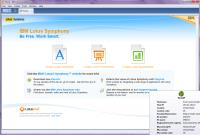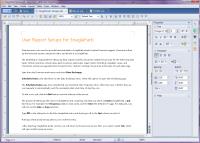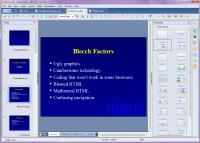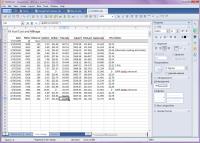The Lotus Position
Remember Lotus 1-2-3, the first "killer application" for PCs? By today's standards , it didn't do very much. But 25 years ago, its capabilities were astonishing. Lotus Development Corporation was founded by Mitch Kapor, a former DJ and friend of the guys who developed VisiCalc. Microsoft introduced an application that eventually pushed Lotus 1-2-3 out of the picture, but before that happened, Lotus released Symphony. IBM acquired Lotus and now there's a new version of Symphony. But it has nothing to do with the earlier applications.
I quote a Wikipedia article: "1-2-3's intended successor, Lotus Symphony, was Lotus's entry into the anticipated 'integrated software' market. It intended to expand the rudimentary all-in-one 1-2-3 into a fully-fledged spreadsheet, graph, database and word processor for DOS, but none of the integrated packages ever really succeeded. 1-2-3 migrated to the Windows platform, where it remains available as part of Lotus SmartSuite. By release 9 of Lotus SmartSuite, 1-2-3 had matched the capabilities of Excel."
But, as I said, the current iteration of Symphony has nothing to do with the earlier iteration.
IBM released version 1.0 of Lotus Symphony in May 2008 as a free download. I'm not sure what happened to version 2, but IBM is preparing to release version 3 of the application, which is based on the open source components of Open Office, which is also the base for Oracle's Star Office suite. Does this remind you of Abbott and Costello's "Who's On First" routine? If not, it should.
IBM announced that the IBM Lotus Symphony 3.0 applications would be released in first half of 2010. That didn't happen and Symphony 3 is now in beta 3 and the release date is closer.
Is IBM Lotus Symphony a replacement for Microsoft's Office Suite? This is not an easy yes/no question because the answer depends on the needs of the user. If you have basic needs, the answer is clearly yes; if you need some of Microsoft's advanced features, the answer is clearly no; between those extremes is a huge gray area.
 Because I'm familiar with myself, let's consider me. Most (which is to say at least 80%) of the time, I use nothing more than the most basic features of Word, Excel, Powerpoint, and Access. Oh—wait. There is no analog to Access in Open Office or Symphony. So if you need a database management system, you'll need more than what these applications have to offer.
Because I'm familiar with myself, let's consider me. Most (which is to say at least 80%) of the time, I use nothing more than the most basic features of Word, Excel, Powerpoint, and Access. Oh—wait. There is no analog to Access in Open Office or Symphony. So if you need a database management system, you'll need more than what these applications have to offer.
Opening an XLSX (Excel 2007/2010) file in Symphony picks up all of the formatting, including Excel's conditional formatting. That's great! But I'm warned that I won't be able to save the file in the XLSX format. That's not so great.
The "big three" applications are word processing, presentations, and spreadsheets. Symphony has those bases covered.
 Symphony's word processor includes many of the functions Word users will be familiar with, although the interface is different.
Symphony's word processor includes many of the functions Word users will be familiar with, although the interface is different.
 Symphony's presentation application includes many of the functions Powerpoint users will be familiar with, although the interface is different.
Symphony's presentation application includes many of the functions Powerpoint users will be familiar with, although the interface is different.
 Symphony's spreadsheet includes many of the functions Excel users will be familiar with, although the interface is different.
Symphony's spreadsheet includes many of the functions Excel users will be familiar with, although the interface is different.
Have you noticed that there seems to be a pattern here?
A Short, Simple Answer
Although Open Office and Wordperfect Office Suite and IBM Lotus Symphony all cover the basics and although each of these applications may be better than Microsoft's version in one way or another, the simple fact is this: Microsoft offers capabilities that no other office suite does and if you need those capabilities, there is no other solution.
 Bottom Line: Most of what you need for free.
Bottom Line: Most of what you need for free.
Because it's based on Open Office, it has a Tray icon. IBM Lotus Symphony might be what you need if you don't need to create files that are 100% compatible with the Microsoft Office standard and if you don't need a relational database application. These applications do what they do very well, but for a lot of people that isn't enough.
For more information, visit the IBM Lotus Symphony 3 beta website.
InDesign CS5, Part 3: The Final Chapter (For Now)
Anne-Marie Concepcion is an InDesign expert. Using the nom de plume Her Geekiness, she writes about design programs such as InDesign and Quark Xpress, but she also knows a lot about social media. We spoke recently about the state of publishing and concluded that ink-on-paper probably isn't going away anytime soon.
This is the 3rd of 3 segments of that discussion in which we talked about Adobe's willingness to listen to users, Lynda.com's offerings, and more:
My InDesign Favorites
There's a lot to like about InDesign and I created an 11-minute video that shows a few of my favorites. Some are new but others have been around for a while. Video highlights:
- Around 2004, when I saw the writing on the wall for the demise of Ventura Publisher and it was clear that InDesign was the program of the future, I complained about InDesign's lack of some features. As I recall, my top complaint had to do with multi-column headlines. The video shows how InDesign exceeded my expectations.
- Drop shadows are overused and can be ugly, but when applied with care they can add the appearance of depth to the page. I use this feature to show InDesign's Quick Apply option. This isn't a new feature. It's been around since at least the CS3 version, but many users don't know it's there.
- Save-as isn't a new feature or one that's unique to Adobe, but it can allow recovery from a catastrophic error.
- As with many other Adobe Creative Suite applications, InDesign has its own built-in MiniBridge so placing graphics is a snap, particularly when combined with the fitting options that Adobe provides.
- Workspaces allow each user to modify the program's interface so that it works the way the user needs it to work.
Those are a few of the features that make Adobe InDesign a pleasure to work with. For those who are working with complex documents such as magazines and books, there are features that allow multiple editors and designers to work on the publication simultaneously. Those features aren't in the video or in my review. In fact, even with 3 programs devoted to InDesign, we've probably covered less than a quarter of the program's most useful features.
To see a larger version of the video, hover your mouse cursor over the box below and then click the 4-headed arrow to expand the play area. You can see a much clearer version by visiting my part of the Vimeo website.
If you read something today — a cereal box, a magazine, a print advertisement — there's a pretty good chance it was created by someone (or a team) using InDesign.
The Advantages of InDesign
Anyone who is responsible for anything that will be printed, whether on a 5-color web press or an office printer, should seriously consider learning about print design. Having done that, you'll soon realize that the de facto page layout program in many offices (Microsoft Word) is an inadequate tool for the job.
Consistency from one document to the next is important. If you maintain a library of documents that describe your company's products or services, each should look like it belongs with the others. All too often, the person who creates these documents doesn't remember the size of the type, the number of columns, or the color used for headlines.
As a result, a prospective client may receive a stack of pages that bear only a slight resemblance to each other.
This consistent look and feel is part of a process that's called branding. Large companies monitor their branding to make sure that colors and typefaces are used consistently and that the company's logo is used properly.
InDesign's templates, paragraph styles, and character styles can be used to enforce standards. You can be certain, for example, that the banner on the newsletter you receive from an InDesign user in December will be exactly like the banner on the newsletter in January. The colors will be the same. So will the typefaces and the overall style. Headlines, colors, and styles will be consistent.
Adopting InDesign costs more than just buying the latest version of Word, both because of the cost of the software and because of the cost of learning how to use the software.
InDesign is not an application that you can install and start using immediately. It helps to have some understanding of typesetting and the terms used by typesetters (font size, line spacing, kerning, tracking, baseline shift, and such). Fortunately, the options for learning about these aspects of typesetting, layout, and design are considerably more numerous than in the past.
Learning InDesign from Experts
One of the best sources for learning how to use software is the Lynda.com website. Both Ann-Marie Concepcion and David Blatner, two well-respected InDesign experts who conduct on-site training, have programs on Lynda.com to share their knowledge of the program.
Although Lynda.com divides training programs into chapters and divides the chapters into bite-size chunks, you'll need to make a significant time commitment to watch the videos and work through the exercises.
Blatner's InDesign CS5 Essential Training title is more than 10 hours long and Concepcion's InDesign CS5 New Features is nearly 3 hours.
In addition, Jim Maivald has a 3.5-hour program on using XML in dynamic workflows and Nigel French offers a 3-hour program on designing book covers in InDesign. Titles are added frequently.
Other resources for learning how to operate InDesign include a website operated by Concepcion and Blatner, InDesignSecrets.com. Others, such as Deke McClelland, Sandee Cohen, Galen Gruman, and Olav Martin Kvern have written books on the subject.
In other words, there's no shortage of resources for learning about this powerful tool.
For more information about InDesign, see the first and second programs in this series.
 Bottom Line: InDesign CS5 is the best page design tool you'll find
Bottom Line: InDesign CS5 is the best page design tool you'll find
(at least until CS6 comes along.)
It's annoying that some features Ventura and Frame users consider basic to the operation of a long-document design application are still missing, but Adobe is working to add those features while maintaining the flexibility inherent in the industry's best page design tool. InDesign feels a lot like a well designed automobile with a powerful engine, smooth transmission, comfortable seats, and an astounding sound system.
For more information, visit the Adobe InDesign website.
Short Circuits
CHASEing Your Money
Oops. Chase Bank wasn't able to provide what the New York Times characterizes as "millions of customers" access to their accounts on Tuesday and Wednesday. I was one of those millions as I attempted to log on and check to see if my Visa card had an outstanding balance.
Chase is the company that acquired Bank One, which tried several times (in the distant past) to establish on-line banking options. The company says that it started hearing complaints on Monday and that full service was restored by 1 am Wednesday morning. That doesn't exactly square with my experience. I wasn't able to log on until Thursday morning.
If this multi-day outage doesn't have Chase customers reconsidering their banking relationship, I wonder what would. Chase didn't provide much information. If you attempted to log on (as I did many times on Wednesday) there was only a vague message that said there was a problem and that Chase was working to fix it. Could they provide any LESS information?
According to the New York Times, "bank spokesman, Joseph Evangelisti, said Chase did not post updates because it was waiting until it had a full understanding of the technical problems. He apologized for the disruption and said Chase would automatically refund any penalty fees incurred as a result of the outage."
The NY Times also says "The severity of the outage is also striking because Chase, the nation's second-largest bank behind Bank of America, has been trying to steer more of its customers toward electronic banking, including services like one that lets clients scan checks using their cellphones and deposit them over the Internet."
Oops.
Read Your Newspaper Electronically
Newspapers are an endangered species. The paper version will go away. No question. Well, maybe there is a question: "When?" The publisher of the New York Times knows that the paper version isn't long for the world. The Columbus Dispatch is promoting its online version.
Now Apple is planning a subscription plan for newspapers, according to the San Jose Mercury News (Apple's hometown newspaper). According to the Mercury News, quoting Reynolds Journalism Institute professor Roger Fidler, "Apple probably will take a 30 percent cut of all subscriptions sold through the company's online App Store, and as much as 40 percent of the advertising revenue from publications' apps." Clever.
Some newspapers currently offer subscriptions to Ipad users, but newspaper owners are hoping that digital subscriptions will help pay for reporters and editors. The Mercury News article says that newspapers are unhappy with Apple's terms. "They had hoped to offer app editions as part of subscription bundles that include print versions of the paper. Instead, they must use Apple as an intermediary with subscribers."
Although Apple will probably dominate the tablet market for a few years, PC manufacturers are working on alternatives. There's also Google's Android operating system and devices such as the Amazon Kindle.
The next few years should be "interesting" for the nation's newspapers.
Arrrrrrr! The 19th of September (today's program date) may be Talk Like a Pirate Day, but that's not why I said "Arrrrrrr!" For the past several weeks, a coding error has caused a problem for anyone who views this site with Internet Explorer. Apparently, that's not too many people because it took a while for the bad coding to cause enough problems for someone to complain.
I'm going to blame the problem on the idiot website designer who set up the styles for this site. Trouble is, that's me. It was simply a case of one misplaced quotation mark. Who says punctuation isn't important?
As far as I can tell, I've found and corrected all of the problems and I've also fixed the saved Dreamweaver snippet that caused the error to be propagated from one program to another.
I apologize for the error.


 The author's image: It's that photo over at the right. This explains why TechByter Worldwide was never on television, doesn't it?
The author's image: It's that photo over at the right. This explains why TechByter Worldwide was never on television, doesn't it?
